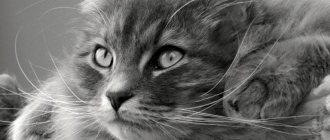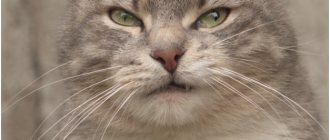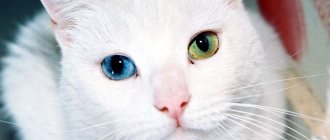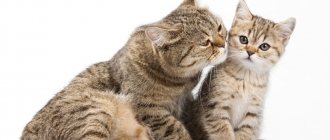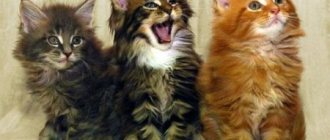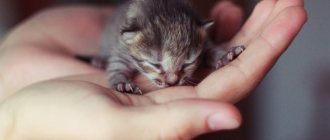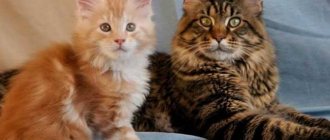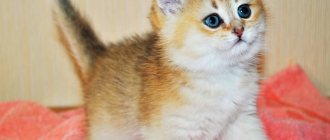How to grow oats at home for cats?
Sprouted oats are a cat’s favorite treat, rich in vitamins and minerals necessary for the full growth of your pet. This herb can cause a gag reflex, which helps the cat get rid of hair and poorly digested food. You can buy seeds at a zoological store and germinate them yourself at home. Moreover, it will require a minimum of cost and effort. There are three ways in which grass will appear within a week: in vermiculite, in soil and without soil.
Benefits of greens for cats
Fresh greens must be present in every cat’s diet; oats have the following positive characteristics:
- The menu supplement contains carotene, magnesium, potassium, phosphorus, silicon and folic acid. Therefore, the herb is indicated for pregnant fluffies.
- By introducing at least a little greenery into your daily menu, you will immediately notice how a cat with a problem stomach has improved digestion. Do not be alarmed if the animal vomits food along with hairballs - this process is normal and natural; with the help of the gag reflex, the “fluffy” stomach is cleared of foreign objects. Veterinarians prescribe sprouted greens to loosen stools; if you suffer from constipation, you need to choose greens with wide and dense stems. It is necessary to secure the feces - lush grass with narrow leaves will do an excellent job with this task.
- Cats are unusual animals with extraordinary taste. Remember how greedily they swallow pieces of newspapers and plastic. But if such experiments are dangerous for a pet, then the grass only has a beneficial effect on the cat’s body. All that remains is to sprout oats for the cat and see with what pleasure the “fluffy” one gnaws on the greens. Also be prepared for the fact that the beast will not be interested in the grass; respecting the taste of the green-eyed beauty, finely chop the oats and mix them into food.
What grass to plant at home for a cat
Place it in a flower pot (wide, low) and water it. The grass grows, all kinds of it! :080: What a pleasure it is to rummage through a pot and choose! And, most importantly, no one swears! :073:
13.04.2009, 18:42
Now I make it easier! From the dacha we bring a small layer of soil from a clean lawn. Place it in a flower pot (wide, low) and water it. The grass grows, all kinds of it! :080: What a pleasure it is to rummage through a pot and choose! And, most importantly, no one swears! :073:
Super idea: support: Any animal should like this: 019:
I like it, I like it! And completely free! :))
Features of growing oats for cats
Veterinarians tell us how to germinate oats for a cat at home. The first thing you need to do is buy a mixture of grains at the pet store, and then sow the mixture and expect the first shoots within a week. There are several ways to grow greens at home:
- The traditional option is in the ground. The container should be wide and shallow. In order for oats to sprout quickly, place the first layer of sawdust or soil on the bottom; the thickness should not exceed 1-2 cm. Before planting the seeds, it is advisable to place the mixture in a sock in water for a couple of hours and then rinse thoroughly. Cover the seeds located in the ground with another layer of soil. Cover the pot with plastic and wait for the sprouts to move. The soil can be replaced with vermiculite.
- In gauze. Take a plastic plate and make 4-5 indentations so that excess water can drain out of the pot. After soaking the grains, place cheesecloth on a plate and place the swollen seeds. Place cling film on top and place the container towards the window. After 3 days, when the first shoots appear, water the oats and cover again. After a week, the cat can already be offered green treats.
It is important that the roots do not dry out - rinse them daily with cool tap water. Here are the reviews that cat lovers leave about the gauze option for growing oats: “I germinate greens without soil, because the animal really likes to dig in the soil, this way I can avoid dirt in the house.”
Oats for cats: how to plant and grow?
Felinologists have not yet come to a consensus on why the cat family is partial to grass. There are several versions of why greens are so beneficial:
- Supplement to the diet. Sprouted wheat, oats, and barley grains contain vitamins, microelements (carotene, potassium, magnesium, phosphorus, silicon and others), as well as acids, including folic acid. The herb is often added to pregnant cats so that she can bear offspring;
- Improved digestion. With the help of grass, the cat cleanses the stomach: coarse fibers quickly remove food debris and accumulated hair from the body. The herb can provoke a gag reflex, or, on the contrary, it can have a strengthening effect. For example, in nature, cats choose greens with wide stems for a laxative effect, and for a strengthening effect - with narrow leaves and stems;
- Goodies. Many cats simply like to nibble on green stems and lick the juice, but cats do not swallow the entire herb. However, tastes are individual; some four-legged pets cannot stand plants, and owners have to secretly mix them into their food.
Useful properties of quail egg shells.
Quail egg shells are an ideal source of calcium, which is easily absorbed by the body. The healing properties of the shell: studies have shown that the shell of quail eggs, consisting of 90% calcium carbonate, is easily absorbed by the body, and in addition contains all the microelements necessary for the body, including copper, fluorine, sulfur, silicon, zinc and others (27 in total elements). The composition of quail eggshells amazingly matches the composition of bones and teeth, and moreover, stimulates the hematopoietic function of the bone marrow. Quail eggs contain a large number of microelements that are beneficial for brain development, have a positive effect on brittle whiskers, faded fur in cats, and also promote rapid healing of bones in case of fractures.
Quail egg shells are useful even for human children, especially during periods of intensive growth, when the need for calcium increases significantly for the formation of bone tissue. It has a beneficial effect on osteoporosis (softening of bones), rickets, and anemia. When including quail egg shells in baby food, you must not forget that calcium is absorbed by the body only in the presence of vitamin D. This vitamin is found in large quantities in fish oil, cod liver, halibut and other marine fish.
Infusions made from quail egg shells have high therapeutic activity. To prepare a calcium solution, take 1 teaspoon of powder per 1 liter of water. Water infused for 5-6 hours is used for drinking, making tea and coffee. The more the powder is crushed, the faster the infusion occurs. The process can be accelerated in an acidic environment; calcium ions and other trace elements are washed out of the shell faster. Calcium is involved in blood clotting processes, so an infusion of quail egg shells helps with pulmonary and gastric bleeding. Shell therapy is indicated for people with irritability, insomnia, brittle nails and hair, bleeding from the gums, and constipation. It is recommended to do it twice a year to prevent spinal diseases, dental caries and osteoporosis. This prevention is especially effective during the winter months. Drinking such water is recommended for pregnant women to enrich the body with calcium ions and other microelements. Calcium-enriched water is used externally to wash bleeding wounds, in the form of compresses (mixed with vegetable oil 1:1) for rapid healing of wounds.
Next: Toys for Maine Coon Cats
Littleone 2009-2012 > Hobbies and interests > About pets > When should a kitten be given oats?
View full version: When should a kitten be given oats?
Manyunya76
09.04.2009, 12:13
Tell me, from what age? I started nibbling on houseplants! ; ))))
Brünnhilde
09.04.2009, 12:28
My opinion - always! (I mean, as soon as the teeth appeared) :)) However, this still didn’t save my indoor plants...
*Svetlana*
09.04.2009, 13:09
Can it be given if the kitten is not on a natural diet, but on drying?
Bellochka
09.04.2009, 13:13
Can it be given if the kitten is not on a natural diet, but on drying? It’s necessary... it doesn’t affect anything... for cleansing, so to speak..:008:
but mine didn’t eat (((for cleansing, she got used to carrying sanitary pads, she’s a gourmet, damn it... and she doesn’t disdain polyethylene... in general, we’ve passed the stage of oats.. “I don’t eat that, I’m not a goat” ((
09.04.2009, 13:26
Our kitty herself started with all the other plants, roses are especially tasty, until the slow-witted owners brought oats. True, this no longer saved the house plants, and the habit of gnawing bouquets remained: flower:, they taste better :004:
My opinion - always! (I mean, as soon as the teeth appeared) :)) True, it still didn’t save my indoor plants... mine too *)
Manyunya76
09.04.2009, 14:47
Thanks a lot. And then they told us that only from 4 months. And we are 2.
IMHO - never. You need to give vitamins and pay attention to the kitten more often. And oats - well, a cat is not a horse... I saw how they grow this hydroponics - there is SO MUCH fertilizer in the solution, it will light up at night. No one washes it before selling it.
*Svetlana*
10.04.2009, 01:59
A very interesting opinion. By the way, I didn’t think about fertilizers. Can't you wash it at home?
What should you give if the poor guy doesn’t eat oats, but does eat indoor flowers? (if the flowers were mine, I wouldn’t worry) :009:
10.04.2009, 17:44
Our experience shows that giving something does not help. Helps NOT to give indoor flowers. Try to remove flowers from the reach zone (fantasy in life), although our kitty has grown to 4-5 months, so all kinds of inaccessible zones have ended. But it’s unlikely that you’ll be able to distract a persistent animal.
*Svetlana*
11.04.2009, 00:29
What should you give if the poor guy doesn’t eat oats, but does eat indoor flowers? (if the flowers were mine, I wouldn’t worry) :009:
If this is a question for me, then try to remove the flowers so that they don’t get them. But how realistic is this:005:
IMHO - never. You need to give vitamins and pay attention to the kitten more often. And oats - well, a cat is not a horse... I saw how they grow this hydroponics - there is SO MUCH fertilizer in the solution, it will light up at night. No one washes it before selling it. why buy ready-made. if you can grow it yourself.. here I grow a grove and nothing for parrots and cats..:) but cats need grass - they cleanse their stomachs. they themselves eat sedge outside in the summer..:)
*Svetlana*
12.04.2009, 01:37
How do you grow it, where do you get the seeds? Can it be planted in regular soil?
12.04.2009, 15:56
my cat can’t stand oats, and she bought them and sprouted them herself, but the flowers……… once got poisoned so that her legs gave out, she just crawled on her front legs, and her hind legs dragged. I brought out almost all the flowers, except for some. doesn't seem to be poisonous, eats and everything is fine
Quiet evening
12.04.2009, 21:00
Tell me, from what age? I started nibbling on houseplants! ; ))))
We are also gnawing. But I'm not worried. Eats only the same flower.
How do you grow it, where do you get the seeds? Can it be planted in regular soil? sold in any pet store in packs of oats. I plant them in ordinary soil for flowers. :) in just a week this is... https://s47.radikal.ru/i118/0904/ae/dd119a9fb88at.jpg (https://radikal .ru/F/s47.radikal.ru/i118/0904/ae/dd119a9fb88a.jpg.html)
13.04.2009, 17:51
Yesterday I bought my oats after reading this topic - at first he was curious, he gnawed a couple of blades of grass... now he doesn’t even look! does it need to be watered?
At one time I sprouted oats myself! The seeds were bought at a flower shop or a pet store. But oats are delicious the first time! And then... :0099: Now I make it easier! From the dacha we bring a small layer of soil from a clean lawn.
How to grow oats for a cat?
The easiest way is to buy a mixture of grains at a pet store and germinate it yourself, especially since it will take no more than a week. There are several ways to germinate oats:
- In vermiculite. A characteristic feature of this mixture is that vermiculite is able to absorb liquid 5-6 times its own weight. If there is a flower shop nearby, go there, vermiculite is inexpensive. The mixture retains moisture, while the plants do not sour or dry out for 2-3 weeks. Oats and vermiculite must first be soaked for an hour, drained and poured into a wide, shallow container. It is better to fill the container 3-4 centimeters, but not to the very top, so that the soil does not spill out later. Cover with a plastic bag or cling film and place on the windowsill. In 3-4 days the first shoots will appear, after another couple of days you can remove the film and offer a “mini-flower bed” to the cat. The beauty of such a “greenhouse” is that the grains will germinate gradually, which means that the animal will be provided with greens for 2-3 weeks. You need to water your home flower bed once every 2-3 days and drain off excess water.
Favorite grass of cats
Cats are intelligent and cautious by nature. And if the owners notice that the cat is “leaning” on a certain type of grass - be it a houseplant or a meadow plant - most likely, it is treating itself. We had a cat, and his favorite plant at one time was aloe. He chewed the plant to smithereens. Later it turned out that he had a diseased liver.
Some plant species, however, are considered poisonous to cats, according to experts. These are geranium, tree of life, yew, calendula, poppy, violets, hellebore, tulip, lily of the valley, hemlock, sea onion, daffodils, henbane, philodendron, oleander, spurge, mistletoe, dieffenbachia, ivy, and all bulbous plants. Most likely, the pet itself will not eat herbs that are dangerous to it. But it’s better to play it safe and not grow the listed plants at home or in your summer cottage.
Valerian, catnip (catnip) and citronella act like a drug on cats. These herbs are certainly loved by cats, but they literally drive them crazy and overstimulate them. Experts do not recommend planting such grass for cats at home.
Of the meadow grasses, cats prefer young, juicy sedge.
The most useful and no less loved by cats are young shoots of oats, wheat and barley sprouts. They can be grown at home without any difficulty.
